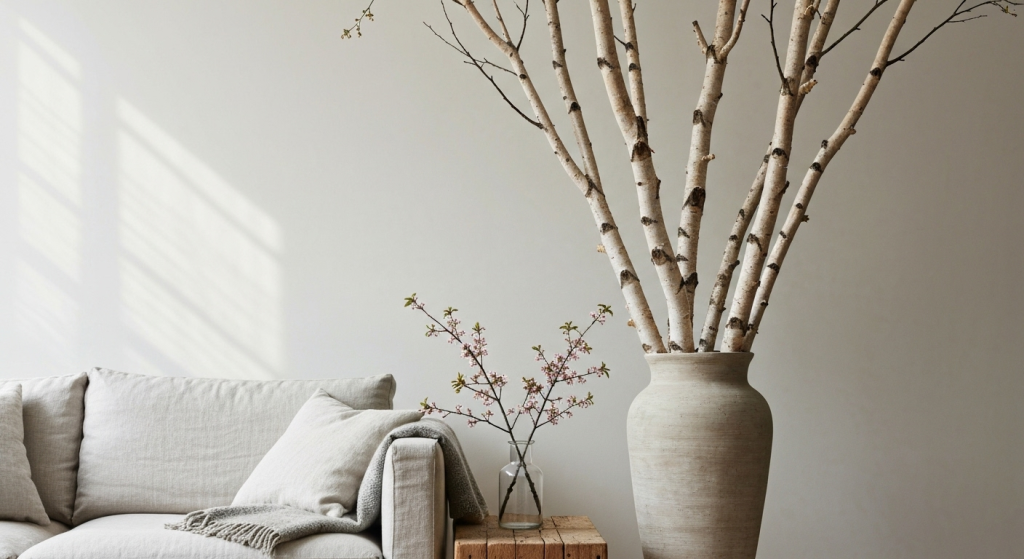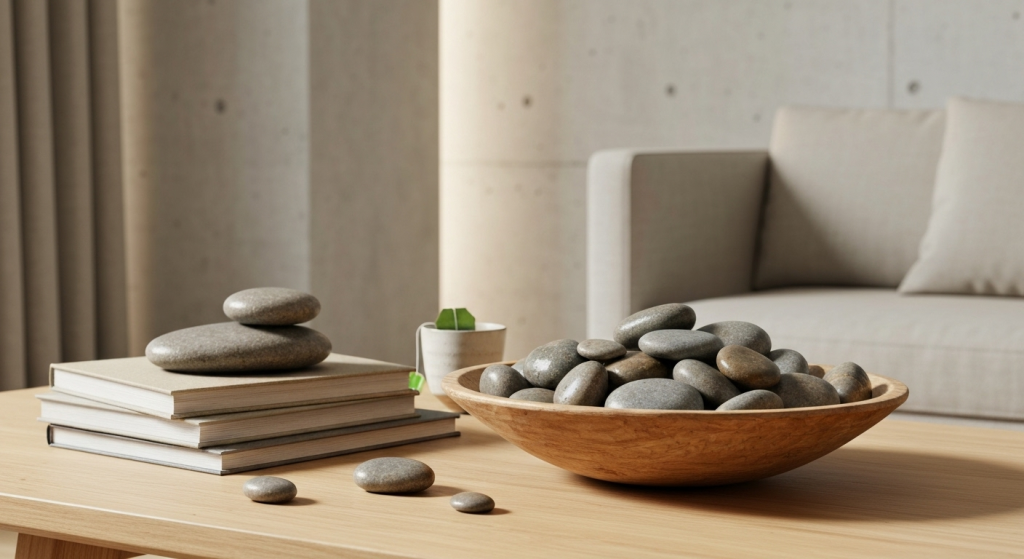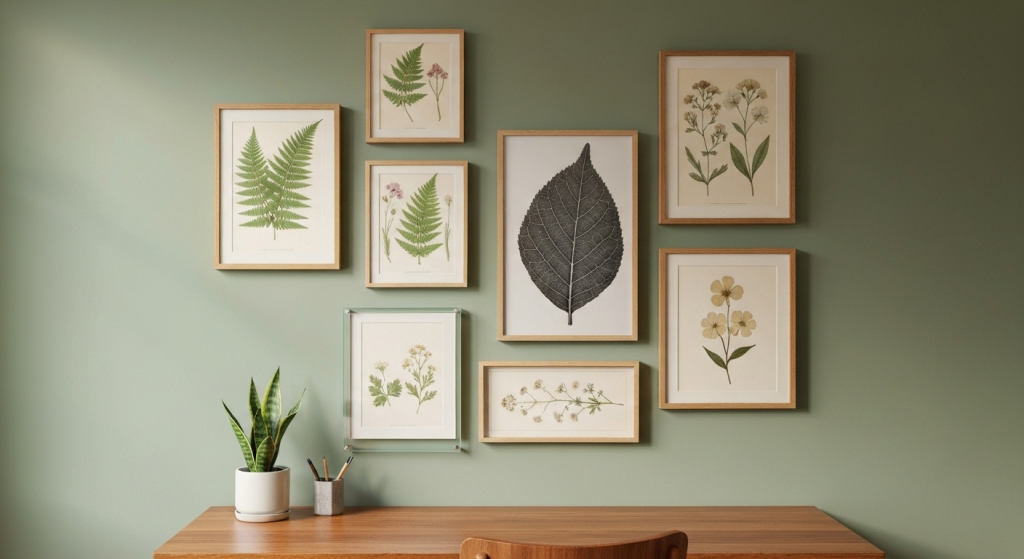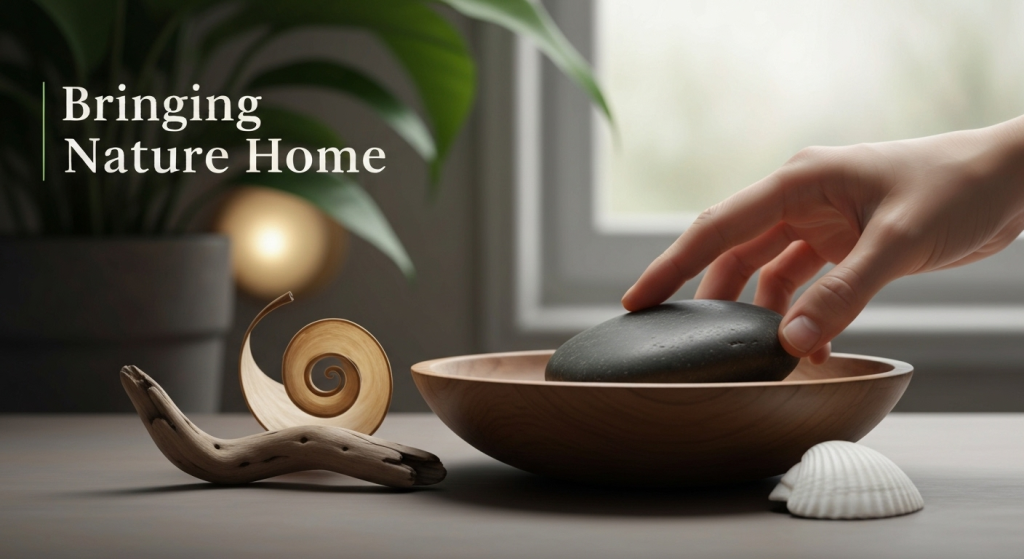Decorating with natural elements is one of the most powerful ways to make a house feel like a home. It’s about more than just adding a few houseplants; it’s about creating a living space that feels calm, grounded, and connected to the world outside your window. When we intentionally bring pieces of the outdoors in, we create a sanctuary that helps us unwind from the busyness of modern life. This approach doesn’t require a big budget or a major renovation. It relies on finding beauty in simple, organic things—a fallen branch, a smooth river stone, or a delicate seashell.
For the past five years, my work has revolved around how simple choices in our homes can deeply affect our well-being. This journey has shown me that the most impactful decor isn’t always the most expensive, but the most meaningful. I’ve spent countless hours exploring how textures, patterns, and objects from nature can quiet a room and soothe the mind. My passion is rooted in finding and sharing these accessible ideas, helping others create spaces that are not just beautiful, but truly restorative and reflective of a peaceful, organic lifestyle.
The ‘Why’ Behind Natural Decor: Understanding Biophilic Design
Before we dive into the “how,” let’s touch on the “why.” There’s a scientific reason why a room with natural elements feels so good. The concept is called biophilic design, which is essentially the idea that humans have an innate tendency to seek connections with nature. When we honor this connection in our homes, we reap real benefits.
What this really means is that our brains are wired to respond positively to natural patterns, materials, and life. Studies have shown that incorporating these elements into our indoor environments can reduce stress, improve our mood, and even increase productivity. It’s not just about aesthetics; it’s about creating an atmosphere that supports our mental and emotional health. You don’t need to be a designer to do this. You just need to be willing to look at the natural world as your ultimate source of inspiration.
Beyond the Potted Plant: The Untapped Potential of Found Objects
While houseplants are a wonderful starting point, they are just one piece of the puzzle. The world is full of beautiful, free decor items waiting to be discovered. Thinking beyond the pot opens up a world of texture, form, and history that can add incredible depth and personality to your home.
The Sculptural Beauty of Branches

A simple branch can be as impactful as an expensive sculpture. Its lines, texture, and form are entirely unique. I once found a large, weathered piece of driftwood on a beach trip, and after cleaning it, I mounted it on the wall above my sofa. It instantly became the focal point of the room, telling a story of the sun, water, and wind.
Finding and Preparing Your Branches
- Where to Look: Your own backyard, a local park (check for rules about collecting), or a walk in the woods are perfect places. Look for branches that have already fallen. Interesting shapes, peeling bark, or bits of moss can add character.
- The Cleaning Process: This is a crucial step to ensure you don’t bring any unwanted pests inside.
- Brush it Off: Use a stiff brush to remove any loose dirt, cobwebs, or flaky bark.
- Wash and Soak: Give the branch a good scrub with a solution of mild dish soap and water. For a deeper clean, you can soak it in a tub with a 10:1 water-to-bleach solution for a few hours. This helps kill any mold or insects.
- Dry Completely: Let the branch dry completely in the sun for several days. The sun is a natural sterilizer. If you’re in a hurry, you can bake smaller branches in the oven on low heat (around 200°F or 95°C) for an hour, but keep a very close eye on them.
Ways to Display Branches
| Display Method | Best For | Pro Tip |
| Large Floor Vase | Tall, dramatic branches like birch or curly willow | Anchor the branches with sand or pebbles in the bottom of the vase for stability. |
| Tabletop Vase | Smaller, delicate branches like cherry blossom | A clear glass vase highlights the branch’s form without competing with it. |
| Wall Art | Uniquely shaped, sculptural pieces like driftwood | Use clear wall hooks or mounting brackets for a clean, floating look. |
| Hanging Display | A single, interesting branch | Suspend it from the ceiling with clear fishing line to create a natural mobile. |
The Grounding Energy of Stones and Pebbles

Stones and pebbles bring a solid, earthy element into your home. Their weight, coolness, and smooth texture can be incredibly grounding. They remind us of ancient mountains, flowing rivers, and the slow, steady pace of nature.
Incorporating Stones into Your Decor
- A Simple Bowl: One of the easiest methods is to fill a shallow wooden or ceramic bowl with a collection of river stones. Placing this on a coffee table or bookshelf creates a simple, zen-like accent. I keep a bowl of smooth, dark stones on my desk and find that simply holding one during a stressful moment can be very calming.
- Vase Filler: Instead of using artificial fillers, place stones in the bottom of a clear glass vase. This not only adds a natural touch but also helps anchor flower stems or tall branches.
- Natural Paperweights: A single, beautiful stone with an interesting color or pattern can serve as a functional and decorative paperweight on a desk or a stack of books.
- Bathroom Accent: Place a few larger, flat stones near the tub or on the vanity. They hold up well in humid environments and can contribute to a spa-like atmosphere.
Remember to give your stones a good scrub with soap and water before bringing them inside to remove any dirt or algae.
Coastal Whispers with Shells and Sea Glass
If you live near the coast or simply love the ocean, shells, sea glass, and even small pieces of coral can bring that serene, beachy feeling home. Each shell is a small miracle of natural engineering and design.
Creative Ways to Use Coastal Finds
- Beyond the Jar: While a jar of shells is classic, try arranging them in a more intentional way. A large clamshell can serve as a natural dish to hold keys or jewelry.
- Fill a Lantern: Place a collection of shells and a flameless LED candle inside a glass lantern for a beautiful, safe, and coastal-themed light source.
- Create a Shadow Box: For more delicate or special finds, arrange them in a shadow box. This turns your collection into a personalized piece of art and protects them from dust.
- Mix with Other Elements: Combine shells with sand in a shallow tray on a coffee table or mix small shells with pebbles in the base of a potted plant to add a subtle coastal touch.
Capturing Nature on Your Walls: Botanical Art and Prints

If bringing physical objects indoors isn’t practical, you can capture the essence of nature through art. Botanical prints are a timeless way to celebrate the beauty of the plant world. They add a touch of sophistication and life to any room.
Finding Your Botanical Style
The great thing about botanical art is its versatility. There’s a style to suit any home decor aesthetic.
- Vintage Illustrations: Classic, detailed drawings of flowers, leaves, and trees bring a historic and academic feel to a space. You can often find high-resolution digital versions from museum archives online that you can print yourself.
- Modern Photography: Macro photographs of a leaf’s veins, a flower petal, or dewdrops on grass offer a contemporary and abstract take on nature.
- Pressed Flower Art: This is a wonderful DIY project. Pressing simple flowers or leaves from your garden and arranging them in a floating glass frame creates a deeply personal and delicate piece of art.
- Abstract Nature Paintings: Look for paintings that evoke a landscape or natural pattern without being literal. A piece with earthy tones and organic shapes can create the same calming effect.
Creating a gallery wall of different botanical prints is a fantastic way to make a statement. I did this in my hallway, mixing vintage fern illustrations with modern photos of leaves. It created a cohesive look that feels both educational and beautiful.
Weaving in Nature: Textiles and Patterns
The fabrics you use in your home are a powerful, yet often overlooked, way to incorporate natural elements. They engage our sense of touch and can visually soften a room, making it feel more inviting and comfortable.
Choosing Natural Materials
Focus on textiles made from natural fibers. They have a texture and breathability that synthetic materials can’t replicate. Their imperfections are part of their charm.
| Fiber | Key Characteristics | Best For |
| Cotton | Soft, breathable, versatile, and easy to care for. | Bedding, curtains, everyday throw blankets. |
| Linen | Strong, absorbent, and has a beautiful, relaxed texture. | Curtains, tablecloths, lightweight throws, pillow covers. |
| Wool | Warm, durable, and naturally moisture-wicking. | Cozy throw blankets, area rugs, chunky knit pillows. |
| Jute/Sisal | Coarse, highly durable, and has a rustic, earthy feel. | Area rugs, placemats, decorative baskets. |
Embracing Nature-Inspired Patterns
Beyond material, the pattern of your textiles can echo the outdoors.
- Floral and Leaf Prints: A classic for a reason. You can go bold with large-scale tropical leaf patterns on accent pillows or subtle with a delicate floral print on your bedding.
- Animal-Inspired Patterns: This doesn’t have to mean a literal zebra print. Think about more abstract patterns that suggest animal hides, feathers, or scales.
- Organic and Abstract Shapes: Look for patterns that mimic the flow of water, the rings of a tree, or the texture of stone. These subtle nods to nature can have a huge impact.
A simple switch, like trading polyester curtains for light, airy linen ones, can completely change the way a room feels, allowing more natural light in and adding a soft, organic texture.
Putting It All Together: Room-by-Room Inspiration
Let’s break down how you can apply these ideas in different areas of your home. The key is to layer these elements thoughtfully, not to overwhelm the space.
The Living Room: Your Social Sanctuary
- Focal Point: A large, sculptural branch mounted above the sofa or a tall vase of birch branches in a corner.
- Texture: A wool or jute rug to ground the space. Linen or cotton throw pillows with subtle leaf patterns.
- Small Touches: A wooden bowl filled with smooth river stones on the coffee table. A single, beautiful piece of coral on a bookshelf.
The Bedroom: A Restful Retreat
- Calming Art: A large, serene landscape photo or a series of pressed flower frames above the bed.
- Textiles: Focus on natural bedding, like soft cotton or relaxed linen. A chunky wool blanket at the foot of the bed adds warmth and texture.
- Subtle Elements: A small dish of seashells on the nightstand. A single, clear vase with a few delicate, dried stems.
The Bathroom: A Spa-Like Escape
- Humidity-Friendly Elements: Stones, pebbles, and shells work perfectly here. Place them on a tray near the sink or on a shelf by the tub.
- Greenery: If you lack light for a real plant, a high-quality print of a fern or tropical leaf can add a lush feel.
- Natural Materials: A bamboo bath mat, Turkish cotton towels, and a wooden soap dish all contribute to an organic, spa-like atmosphere.
Frequently Asked Questions
How do I clean natural elements to make sure I’m not bringing bugs inside?
For wood and branches, scrub them with soap and water, then let them dry completely in the sun for several days. For a more thorough job, you can soak them in a 10:1 water-and-bleach solution. For stones and shells, a simple scrub with soap and hot water is usually enough.
I live in a city and don’t have easy access to forests or beaches. What are my options?
You can still achieve this look! Visit local farmer’s markets for interesting dried florals or branches. Many craft stores sell bags of river stones, shells, or driftwood. And don’t forget the power of botanical art and textiles with nature-inspired patterns, which are accessible to everyone.
How do I incorporate these elements without making my home look cluttered or messy?
The key is curation. Instead of displaying everything you find, choose a few special pieces. Think “less is more.” Group similar items together, like a collection of stones in one bowl, rather than scattering them around the room. This creates intentional focal points instead of clutter.
Are these natural decor items safe for homes with pets or small children?
Always be mindful. Ensure any large branches are securely mounted or placed in a heavy, stable vase. Small items like stones or shells can be a choking hazard for young children, so place them out of reach. Be aware of which plants or branches might be toxic to pets if they are prone to chewing things.
Conclusion: Start Small, Find Joy
Decorating with natural elements is less about following strict rules and more about cultivating a personal connection with the world around you. It’s an invitation to slow down, to notice the beauty in the imperfect, and to create a home that truly nurtures you. Start with one small thing. Pick up an interesting stone on your next walk. Buy a single linen pillow cover. Hang one beautiful botanical print. You’ll be surprised at how quickly these small, intentional acts can transform your space, making it a calmer, more beautiful, and more authentic reflection of you.


